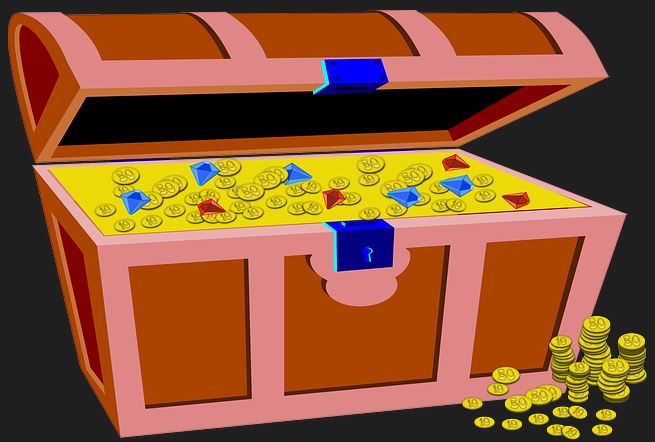Since the Great Financial Crisis of 2008, there have been headlines such as Europe banks hoarding ECB cash, threatening credit crunch (2012), Banks across Europe are considering taking a drastic step to avoid negative rates (2016), and Bank of America Clients Hoard Cash at Highest Level in Two Decades (2022). This first became a problem in the US during the Dot.com Crash (2001) and the GFC – and then shifted to Europe. After all this time, we in America might have a more dispassionate view of the issue. But the third reference above shows the problem of hoarding money persists.

Image credit: Pixabay, Public Domain.
An Ancient Problem, Ignored for Centuries
From Moses to Locke, everyone knew about hoarding. Ever since Adam Smith, nobody does. Worse, since the days of Smith, economists are under formal obligation not to utter the word hoarding. Their economic models do not, and indeed cannot, include hoarding. Their models say that all wealth that is not consumed is saved—and saving equals investment. Therefore, there is no room for hoarding in their models. Hence, economists have to maintain that hoarding does not exist.
Hoarding Maven
M. L. Burstein, one of the sharpest minds in economics of the last century, once called me the “Hoarding Maven.” In fact, more than forty years of research and publication—twenty-seven of them assisted by the late Nobel laureate Franco Modigliani and twenty-three years assisted by Professor Burstein—have led me to a conclusion that is different from the one reached by most economists.
Rather than jettisoning hoarding from our purview, we must jettison all those mainstream economic models that, as it is widely acknowledged, have left us unawares and contributed to lead us into the current crisis. I have indeed replaced those models with a set of more realistic models that include hoarding in their framework of analysis. These models can be found in The Economic Process, as well as in articles published in numerous scholarly journals and in the nineteenth volume of Progress in Economics Research, edited by Albert Tavidze.
I have lately called the new paradigm “Concordian economics.” See An Overall View of Concordian Economics.
What is hoarding?
As Burstein recognized, hoarded is all wealth that at the moment of observation has a zero-use rate. Hence, banks can and do hoard cash.
And while banks at times hoard cash, individual human beings, as well as all other businesses, at times hoard not only cash but also real wealth.
Hoarding and Investment, Growth and Poverty
When hoarding is put in relation to investment, as in the well-known Lorenz diagram below, one can make three fundamental observations: The more hoarding, the less growth; the more hoarding, the more inflation; the more hoarding, the more poverty.

More hoarding clearly equals less investment—hence less economic growth. Again, the relationship between hoarding and poverty is of immediate comprehension: more is accumulated by the few, less is available to the many.
Hoarding and Inflation
The explanation of why when there is more hoarding there is more inflation resides in this simple fact. When one buys property and keeps it in a passive state, the money used to buy that wealth remains in circulation and creates an imbalance with the amount of wealth that is for sale in the market. Hence, prices rise. That is the seed of inflation.
Hoarding and Deflation
The difficult nature of hoarding is revealed by this simple fact. At times when financial and industrial corporations hoard cash, hoarding performs a deflationary function. This is a peculiar function that, apart from few aberrant cases (and the general case of economies with insignificant financial institutions), occurs only at the bottom of the crisis and is quantitatively miniscule when put in relation to the value of the economic system over the entire business cycle.
Dealing with Hoarding
Rather than remaining on these fascinating issues, which are treated at some length in my book, I would like to stress the key conclusion that I had to reach on the basis of my work. Dr. Michael Emmett Brady, one of the clearest minds in economics these days (full disclosure, I am the junior author of a paper we published together1, points out in his review of my book that the phenomenon of hoarding is not new. Hoarding is at least four thousand years old. In fact, Professor Brady highlights,
“Keynes states this on pp. 241-42 and 351-52 but does not emphasize it for his economist audience. G[orga] emphasizes it and convincingly identifies it as the main problem” of “a destabilizing boom-bust business cycle over time.”
The key conclusion of my work is this. Do not try to fight hoarding head-on. You will lose, because hoarding is rooted in an essential human characteristic: the instinctive search for economic security. Fight, instead, all those institutions that increase economic insecurity and compel human beings to hoard wealth in order to find some personal, individual sanity in a crazed world.
Looking Forward
The complexity of the issues is revealed by the circularity of events: the more people hoard, the more destabilized the economic system becomes. But the individual, alone, is left with no rational alternative. It is society as a whole that creates insecurity, and society alone can break the vicious circle.
How? Here’s a hint: By running the economy to the tune of justice.
To admit to the existence of hoarding and to include this phenomenon into macroeconomic models is the easy part. After that the discourse shifts on to economic policy, which we must reserve for another time.
Note: This is a revision of the article Hoarding and Most Economists published on the History News Network, Columbian College of Arts & Sciences, George Washington University.
Footnote
(1) Michael Emmett Brady and Carmine Gorga. 2009. “Theory of Effective Demand into Keynes’s Decision Theory: Toward a New (and Final?) Interpretation of the General Theory”. International Journal of Applied Economics and Econometrics, Volume 17, number 3, pp. 195-235 (July-September).